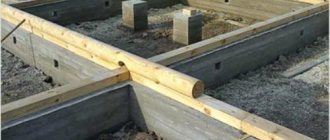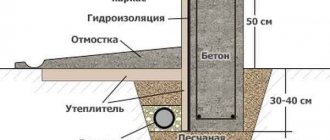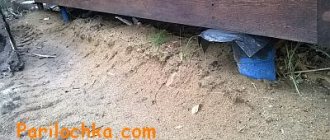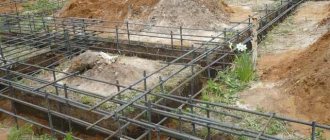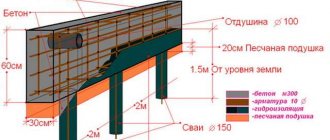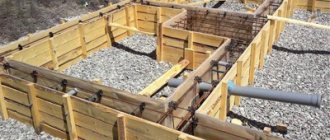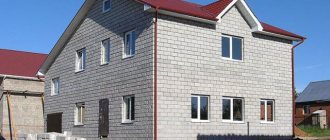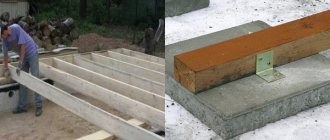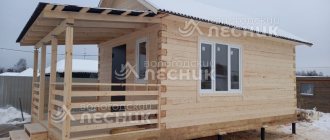Home |Construction |Which foundation is better on clay soil?
Date: November 9, 2018
Comments: 0
The basis of any structure is the foundation, which determines the service life of the construction site. The costs of arranging the foundation make up a third of the total estimated costs and it is not advisable to save on it. High-quality building materials do not always guarantee strength. The surface on which construction is carried out is of no small importance. The foundation on clay soil is fundamentally different from pouring the foundation in black earth regions.
Building a reliable foundation on a heaving foundation is a serious task. After all, it can behave unpredictably, which is associated with the ability to retain moisture and push out the building. Tricky clay is easily washed away by water, loses its integrity, and opens the way for moisture to the elements of the constructed building.
Before building on problematic soil, study its properties and decide on the type of construction. The cost of error is high. These are cracks, failures and possible destruction of the building. The construction of a capital facility in a clay soil zone requires the help of design organizations. If you plan to build an outbuilding, bathhouse or premises for a vehicle, then you can cope with this task yourself by studying the recommendations specified in the article.
The main feature of clay is the ability to quickly erode under the influence of water, without letting it penetrate deeper
Types and characteristics of clay soils
Not a single building, even the most insignificant one, is placed directly on the ground - it needs a foundation. Its main purpose is to ensure the stability of the structure, its stationary position. Without fulfilling this condition, you cannot expect that the house, garage or bathhouse will last long. Uneven movements will certainly lead to the appearance of cracks, faults, stresses in fastening points, and failures. And even if the house does not fall apart, it will eventually become uninhabitable.
The risk of obtaining such a result is especially high when choosing an unsuitable foundation on complex soils, which include clay soils. This is due to their composition and related properties.
Advice! Do not start construction without familiarizing yourself with the results of geological surveys in your area. It’s even better to conduct them directly on your site. They will also help determine where it is possible and whether it is worth drilling a well or digging a well on the site.
Any large construction project should begin with a soil analysis Source magmageo.ru
You can do without a site-specific project only when constructing secondary buildings, such as a utility block or a gazebo. Moreover, by the time of their construction, the main buildings are already ready, and the completed excavation work allows us to judge possible risks. For permanent buildings, a project with all calculations is required. Especially on heaving soils.
To understand which foundation is best for clay soil, you need to know about its properties.
There is such a thing as frost heaving of the soil. In simple terms, this means that it is saturated with water and holds it, and during severe frosts this water freezes, increasing in volume. Accordingly, the soil also becomes more voluminous, so it begins to bulge upward along with all the structures located in it.
It is easy to imagine what will happen to the house if the foundation underneath it moves, and even unevenly.
Heaving forces easily squeeze even heavy structures out of the ground Source eurolos.pro
Clay soils have the ability to retain water. They consist of small lamellar particles, impenetrable to moisture, which is retained between them. On the other hand, large volumes of water are capable of eroding clay and transporting it with its flow, which leads to the exposure of foundation elements and its freezing.
However, the percentage of such particles in the soil may vary not only in one area, but also in neighboring areas. And its characteristics and what kind of foundation to make on clay soil largely depend on this:
- Clay content less than 5% does not affect soil permeability. Such soils are called sandy. They allow water to pass through perfectly and become compacted under load, so any foundation can be built on them.
- 5-10% of clay in sand is sandy loam, which in a dry state is also a reliable base for the foundation and is little susceptible to heaving. But when saturated with water, it becomes fluid and can move with its flow. Such soil is called quicksand; it is formed when groundwater is high. It is undesirable to build on it, but if there is no other choice, use a pile foundation.
Pile foundation on quicksand Source stroyfora.ru
- Loams are light, medium and heavy depending on the percentage of clay in the sand (from 10 to 50%). Which foundation is better on loamy soil, which is extremely susceptible to frost heaving, depends on its homogeneity, density, freezing mark, level of the formation, its thickness and groundwater level. If it is high, emergency subsidence of a building on a shallow strip foundation is inevitable. If the aquifers are located much below the freezing point, the heaving will not be so pronounced. But you also need to take into account factors such as the level of precipitation, the proximity of a natural reservoir and many others.
Preparatory activities
If there is no choice and you have to build a foundation on clay soil, pay special attention to the following points:
- the type of clay-containing soil, which is determined during survey work involving drilling and sampling at the future foundation depth. Perform geological exploration in the spring, when the groundwater level is at its maximum, which allows for detailed research;
- the level of soil freezing for your area, which is determined for a specific region using reference information;
- moisture concentration. Humidity can be determined by leaving the sample to dry in the open air. If the process takes several hours, this indicates high humidity, causing swelling;
- the depth of aquifers located in the upper layers of the soil. Having drilled a hole and guided by the nearby well, you will assess the level of the location of the aquifers.
Let us dwell in detail on the types of clay soils.
Clay soils are called heaving soils, and before starting construction it is strongly recommended to conduct studies of the composition and homogeneity of soils on the site
What else needs to be considered
As you can see, each type of soil can behave differently depending on its composition and ability to pass or retain water. Loam is especially difficult in this regard: what foundation to choose for building a house on such soil is a difficult question. And the answer to it can only be given after clarifying a few more points. Namely:
- at what depth do the aquifers lie, how much do their levels rise during the period of snow melting, floods and heavy rainfall;
Standing water complicates construction on clay soil Source ogorodsadovod.com
See also: Catalog of popular sites in the Moscow region for building a country house
- degree of soil saturation with water;
- to what level does the soil freeze in winter, does groundwater go beyond it or lie below it and by how much;
- what is the relief of the site, are there any significant differences in height or depressions;
- How homogeneous is the soil at the construction site, are there any voids or volumetric inclusions of a different density and friability;
- what is the expected load on the foundation from the constructed building along with the finishing, equipment and other contents. There is a big difference which foundation is better for a frame house on loamy soil and for a two-story brick one, since the building will put pressure on it with different forces.
It is impossible to answer these questions yourself, as well as calculate the loads. Although some “experienced” builders, trying to get a contract to build a foundation, imitate an analysis of the soil composition by digging holes, extracting rock samples from them and carrying out simple manipulations with them, such as kneading them in their hands or drying clay balls in the sun.
To obtain reliable results, such amateur research is not enough Source www.tsn24.ru
This is why it is so important to conduct professional geological surveys, in which samples are taken at different depths and in several places, and then sent to a laboratory for research. Based on the results obtained, the climatic conditions of the area and other system data, experts draw conclusions about how the soil will behave in different conditions, which foundation is better in swampy areas for a house made of different materials. And they give recommendations on choosing its type.
Such a service is not cheap, but if you compare this money with the costs of construction and the possible costs of altering the foundation (which is not always possible), then its necessity becomes obvious.
If we talk about geological surveys, the standard procedure for selecting material includes drilling 3 wells in an area, mainly under a construction site, to a depth of at least 8 meters. If a company offers you to make a well to a depth of, for example, 3 meters, you should think about how reliable the report you will receive as a result.
Anzhelika Avdeeva
Head of Sales Department, KZS LLC
Scope of application of strip foundations
The easiest way to deal with heaving soils is to install a pile foundation below the freezing mark. If it is impossible to carry out such construction, an alternative solution is shallow foundations, which will require significantly smaller volumes of building mixtures, amounts of reinforcement and labor costs.
It is effective to use shallow burial technology when groundwater is located at a depth of more than 1.5 m. Ribbon structures on steep slopes, where lateral pressure must be taken into account, make it possible to compensate for the uneven impact of soil movement in the longitudinal and cross sections.
The foundation on heaving soils is suitable for the construction of frame and timber buildings, the use of foam concrete and aerated concrete materials. If it is necessary to construct a shallow foundation or build powerful structures on soft soils, strip foundations are a priority. Such construction methods are applicable for clay and sandy loam soils, loose rocks, as well as water-saturated surface layers.
Strip base of a house with a brick plinthSource domastroim.ru
Choosing a foundation depending on soil characteristics
After examining the construction site and obtaining data on soil freezing and the level of interlayer water, you can choose a house design, calculate the loads and determine the optimal type of foundation. This task is best handled by specialists from design organizations, but general recommendations can also be given.
See also: Catalog of companies that specialize in foundation construction
Shallow monolithic tape
In order for the foundation to withstand the negative influence of the soil, maintaining stability and strength, it must rest against dense, non-freezing rocks. This means that shallow foundations are not suitable in this case. They are allowed to be installed only if the aquifers are located much below the freezing mark, with insignificant heaving and a small mass of the building.
This type is chosen when you need to decide which foundation is best for a house made of timber on clay soil. It is not suitable for brick and stone houses. Source bouw.ru
But even under these conditions, it is impossible to guarantee that the building will not deform. Therefore, additional safety measures should be taken:
- make the base expand downwards, in the form of an inverted letter T. A wide platform better resists buoyancy forces;
- install it on a powerful, permeable bed of sand and gravel, compacting it thoroughly;
- backfill the foundation trench with sand to level out lateral loads.
Note! It is better to make a strip foundation monolithic with reinforcement, rather than prefabricated from foundation blocks, in which each element will move independently.
Scheme of a shallow strip foundation Source stroyfora.ru
And yet this option is the least preferable and is used to save costs in the construction of non-residential buildings of secondary importance - various outbuildings, sheds, bathhouses, summer country houses.
Recessed strip foundation
When choosing which foundation is best on clay soil for building a large house or a house with a basement, they often choose a strip foundation, buried at least 50 cm below the freezing level. Installed on a strong and non-freezing foundation, such a foundation will not experience bulging pressure from the soil.
But it is important that it is not washed away by nearby groundwater. If they lie higher, they greatly complicate construction, requiring the simultaneous installation of a drainage system to drain water from the pit.
Base requirements
To avoid foundation deformations, it is necessary to have information about the reasons for their occurrence. The main ones are:
- drawdown;
- bulging;
- displacement with shift.
The reason for foundation subsidence is the discrepancy between the actual supporting area and its norm. The occurrence of buckling and lateral shear is associated with incorrect foundation depth when the foundation is exposed to frozen soil.
Which clay foundation will best withstand all loads, taking into account horizontal and vertical vibrations when the soil freezes? There are not many requirements for such a foundation:
- it is prohibited to lay a foundation made of block elements;
- mandatory use of a reinforcing frame over the entire area;
- the presence of a wider sole (when compared with the upper part of the foundation);
- use of material for waterproofing the sole.
Video description
The following video will show you how to install driven piles:
- bored, formed directly on the construction site by drilling deep wells around the perimeter of the future house. The bottom of each well is covered with a layer of crushed stone, large-section asbestos or metal pipes are lowered into it, a reinforcing frame is installed in the pipes and they are filled with high-grade concrete with mandatory compaction with an in-depth vibrator;
To install the grillage, reinforcement is released from the piles or embedded fasteners are installed in the concrete that has not yet hardened Source himmashstroi.ru
Briefly about the main thing
It is impossible to unambiguously recommend one or another foundation on loam - which is better and which is not suitable at all - without accurate information about the characteristics of the soil at a specific construction site. Soils with a high clay content are considered the most problematic when choosing and constructing a foundation that needs to be stable and able to withstand vertical and lateral loads. But now you know what types of foundation you will have to choose from, and you will be able to demand that the contractor strictly fulfill the design requirements.
| Additionally The exhibition of houses “Low-Rise Country” expresses sincere gratitude to the specialists for their assistance in creating the material. (Royal Pile Factory) – expert in pile foundations. If you need more detailed advice, you can use the following contacts: website: kzs.ru email: tel.: 8-800-222-76-17 |
Ratings 0
Read later
Construction of a slab-type foundation - pour a monolithic slab on clay
A slab foundation is also called a floating foundation. When the soil moves, the solid slab moves with it, preventing deformation of the building and evenly distributing the load. Construction of a slab foundation is a costly undertaking. However, the slab provides increased stability of various buildings on problematic soils.
The procedure for constructing a floating foundation involves the following work:
- Marking the site for the foundation slab.
- Extraction of soil to a given depth.
- Construction of formwork around the perimeter of the foundation pit.
- Backfilling and compaction of crushed stone-sand cushion.
- Assembly and placement of the power grid inside the formwork.
- Pouring concrete and vibrating compaction.
A costly event - the construction of a slab foundation
The thickness of the slab is determined based on calculations. Such a foundation can withstand soil deformation and ensures the stability of any building.
